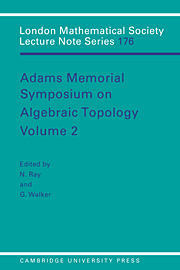Book contents
- Frontmatter
- Contents
- Preface
- Contents of Volume 1
- Programme of one-hour invited lectures
- Programme of contributed lectures
- Programme of Posters
- Participants in the Symposium
- Addresses of Contributors
- 1 Progress report on the telescope conjecture
- 2 On K*-local stable homotopy theory
- 3 Detruncating Morava K-theory
- 4 On the p-adic interpolation of stable homotopy groups
- 5 Some remarks on υ1 -periodic homotopy groups
- 6 The unstable Novikov spectral sequence for Sp(n), and the power series sinh−1(x)
- 7 Unstable Adams spectral sequence charts
- 8 On a certain localization of the stable homotopy of the space XΓ
- 9 Cooperations in elliptic homology
- 10 Completions of G-spectra at ideals of the Burnside ring
- 11 Theorems of Poisson, Euler and Bernouilli on the Adams spectral sequence
- 12 Algebras over the Steenrod algebra and finite H-spaces
- 13 The boundedness conjecture for the action of the Steenrod algebra on polynomials
- 14 Representations of the homology of BV and the Steenrod algebra I
- 15 Generic representation theory and Lannes' T-functor
- 16 Some chromatic phenomena in the homotopy of MSp
- 17 On a conjecture of Mahowald concerning bordism with singularities
- 18 Topological gravity and algebraic topology
7 - Unstable Adams spectral sequence charts
Published online by Cambridge University Press: 18 January 2010
- Frontmatter
- Contents
- Preface
- Contents of Volume 1
- Programme of one-hour invited lectures
- Programme of contributed lectures
- Programme of Posters
- Participants in the Symposium
- Addresses of Contributors
- 1 Progress report on the telescope conjecture
- 2 On K*-local stable homotopy theory
- 3 Detruncating Morava K-theory
- 4 On the p-adic interpolation of stable homotopy groups
- 5 Some remarks on υ1 -periodic homotopy groups
- 6 The unstable Novikov spectral sequence for Sp(n), and the power series sinh−1(x)
- 7 Unstable Adams spectral sequence charts
- 8 On a certain localization of the stable homotopy of the space XΓ
- 9 Cooperations in elliptic homology
- 10 Completions of G-spectra at ideals of the Burnside ring
- 11 Theorems of Poisson, Euler and Bernouilli on the Adams spectral sequence
- 12 Algebras over the Steenrod algebra and finite H-spaces
- 13 The boundedness conjecture for the action of the Steenrod algebra on polynomials
- 14 Representations of the homology of BV and the Steenrod algebra I
- 15 Generic representation theory and Lannes' T-functor
- 16 Some chromatic phenomena in the homotopy of MSp
- 17 On a conjecture of Mahowald concerning bordism with singularities
- 18 Topological gravity and algebraic topology
Summary
Abstract. We present charts for the E2 term of the unstable Adams spectral sequence for π*Sn, complete out to the 60-stem, for 3 ≤ n ≤ 25 at the prime 2, and complete out to the 81-stem for 3 ≤ n ≤ 15 at the prime 3. The charts are produced from the computer calculations of Curtis, et al [2], extended by Mahowald [4] (p=2) and Tangora [6] (p=3), using a EC language program to convert the Lambda algebra files into LaTEX typesetting code.
The purpose of this paper is to present the computer calculations of the unstable Adams spectral sequences for spheres of Curtis, et al [2] (extended by Mahowald [4]) and Tangora [6] in the conventional (t – s, s) chart presentation, thereby making these results more accessible to homotopy theorists. The main tool is a C language program which inputs the ASCII files of Lambda algebra calculations and has as its output ASCII files written in the LaTEX typesetting code ([3]).
The Unstable Adams spectral sequence (UASS) converges to the p-component of the homotopy groups of the n-sphere, Sn. The E2 term of the UASS can be calculated by homological algebra techniques, using [1], where it was shown that the E2 term of the classical Adams spectral sequence (clASS) converging to the p-component of the stable homotopy groups of spheres, φ*, S0, is isomorphic to the homology of the differential graded algebra Λ.
- Type
- Chapter
- Information
- Adams Memorial Symposium on Algebraic Topology , pp. 87 - 118Publisher: Cambridge University PressPrint publication year: 1992



